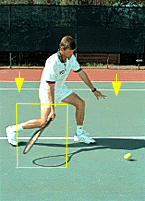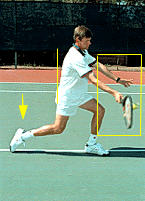|
TennisOne Lessons

The Half-Volley -
Feel the Bump and Stay In the Point
Mark Fairchilds, Head Pro, Modesto
Fitness and Racquet Club
Photographs by Steve Margheim
If we had a choice, none of us would ever play a half-volley.
It's basically a defensive shot, although in the hands of masters like John
McEnroe and Pat Cash, it can sometimes be turned into an offensive shot.
Now that I've said that, you should forget it: think of the half-volley
as a defensive shot where you're playing to get back to a neutral position. Why are you on the defensive when playing a half-volley? Simple, you're
approaching the net and your opponent has driven the ball down in front
of your on-rushing feet. You must abruptly slow down, time the bounce of
the ball, hit the ball near to the ground (often short-hopping it), and
clear your shot over a very-close net. If do all that successfully, you
still have to keep the ball deep enough in your opponent's court so he doesn't
slaughter the next shot.
So, no doubt about it, the half-volley is trouble. But it's not an impossible
situation, and you shouldn't give up on the shot, as I've seen many club
players do. To play the half-volley correctly, you should remember
that it is a volley stroke and most of the essentials remain the same: stay
low, move your head towards the ball, and use a firm wrist. You
might take a bit more of a backswing on the half-volley, particularly if
you're hitting from the service line, but nearer the net, there's almost
no backswing.
Above all other principles of hitting the half-volley, remember the
half-volley is primarily a touch and timing shot. Let's look at
the first photo below. Notice I've bent my knees quite deeply to get down
to the ball. My head is still and my eyes are riveted on the ball. The
feeling of the correct half-volley hit is a "bump." Bump
is not a power word - but I've told you the half-volley is a defensive shot
- and merely describes a firm collision between the racquet and the ball.
Further, the bump only borrows the speed from the incoming ball and does
not add speed or acceleration to the outgoing shot.
  |
Notice the position of my hands and racquet in both photos. To bump the
ball squarely, I've placed my hand and racquet directly behind the ball.
In general, you want to have a slightly closed (first photo) or vertical
racquet face (second photo) when you bump the ball - depending on the bounce
and velocity of the incoming ball. An open racquet face on a rising ball
will normally send the ball out of the court or give your opponent an easy
pop-up to put away.
Notice in the second photo that while my upper body is vertical and balanced,
I've kept my deep knee bend to stay low to the ball (I'm not bent over,
reaching for the ball). So I've stayed low, moving my hands together
to meet the ball, again much like I would when volleying a ball in the air. I'm meeting the ball well in front of me and keeping a firm wrist - again
two basic volleying principles. Everything is simple, streamlined,
and focused. My intent is not to hit a winner but to block the ball deep
so that I have the opportunity to regain the initiative. But let
me end on a more positive note. A soundly played half-volley can dishearten
your opponent because he thinks he's hit a winner. So don't give up when
your opponent has drilled one at your feet. Stay low, feel the bump, and
stay in the point.
|
|